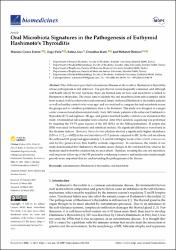| dc.contributor.author | Erdem, Mustafa Genco | |
| dc.contributor.author | Ünlü, Özge | |
| dc.contributor.author | Ateş, Fatma | |
| dc.contributor.author | Karis, Denizhan | |
| dc.contributor.author | Demirci, Mehmet | |
| dc.date.accessioned | 2024-01-03T11:37:32Z | |
| dc.date.available | 2024-01-03T11:37:32Z | |
| dc.date.issued | 2023 | en_US |
| dc.identifier.citation | Erdem, M. G., Unlu, O., Ates, F., Karis, D., & Demirci, M. (2023). Oral Microbiota Signatures in the Pathogenesis of Euthyroid Hashimoto's Thyroiditis. Biomedicines, 11(4), 1012. https://doi.org/10.3390/biomedicines11041012 | en_US |
| dc.identifier.uri | https://hdl.handle.net/20.500.12900/292 | |
| dc.description.abstract | One of the most prevalent autoimmune illnesses in the world is Hashimoto's thyroiditis, whose pathogenesis is still unknown. The gut-thyroid axis is frequently examined, and although oral health affects thyroid functions, there are limited data on how oral microbiota is linked to Hashimoto's thyroiditis. The study aims to identify the oral microbiota from saliva samples taken from treated (with levothyroxine) and untreated female euthyroid Hashimoto's thyroiditis patients as well as healthy controls who were age- and sex-matched to compare the oral microbiota across the groups and to contribute preliminary data to the literature. This study was designed as a single-center cross-sectional observational study. Sixty (60) female patients with euthyroid Hashimoto's thyroiditis (HT) and eighteen (18) age- and gender-matched healthy controls were included in this study. Unstimulated saliva samples were collected. After DNA isolation, sequencing was performed by targeting the V3-V4 gene regions of the 16S rRNA on the MiSeq instrument. R scripts and SPSS were used for bioinformatic and statistical analysis. No significant differences were found in the diversity indices. However, Patescibacteria phylum showed a significantly higher abundance (3.59 vs. 1.12; p = 0.022) in the oral microbiota of HT patients compared to HC. In the oral microbiota, the euthyroid HT group had approximately 7, 9, and 10-fold higher levels of the Gemella, Enterococcus, and Bacillus genera levels than healthy controls, respectively. In conclusion, the results of our study demonstrated that Hashimoto's thyroiditis causes changes in the oral microbiota, whereas the medicine used to treat the condition had no such effects. Therefore, revealing the core oral microbiota and long-term follow-up of the HT process by conducting extensive and multicenter studies might provide some important data for understanding the pathogenesis of the disease. | en_US |
| dc.language.iso | eng | en_US |
| dc.publisher | MDPI | en_US |
| dc.relation.isversionof | 10.3390/biomedicines11041012 | en_US |
| dc.rights | info:eu-repo/semantics/openAccess | en_US |
| dc.subject | Hashimoto tiroiditi | en_US |
| dc.subject | Hashimoto’s thyroiditis | en_US |
| dc.subject | Otoimmünite | en_US |
| dc.subject | Autoimmunity | en_US |
| dc.subject | Ağız mikrobiyotası | en_US |
| dc.subject | Oral microbiota | en_US |
| dc.title | Oral Microbiota Signatures in the Pathogenesis of Euthyroid Hashimoto's Thyroiditis | en_US |
| dc.type | article | en_US |
| dc.department | İstanbul Atlas Üniversitesi, Tıp Fakültesi, Temel Tıp Bilimleri Bölümü | en_US |
| dc.authorid | Özge Ünlü / 0000-0002-5411-5925 | en_US |
| dc.contributor.institutionauthor | Ünlü, Özge | |
| dc.identifier.volume | 11 | en_US |
| dc.identifier.issue | 4 | en_US |
| dc.relation.journal | Biomedicines | en_US |
| dc.relation.publicationcategory | Makale - Uluslararası Hakemli Dergi - Kurum Öğretim Elemanı | en_US |

















